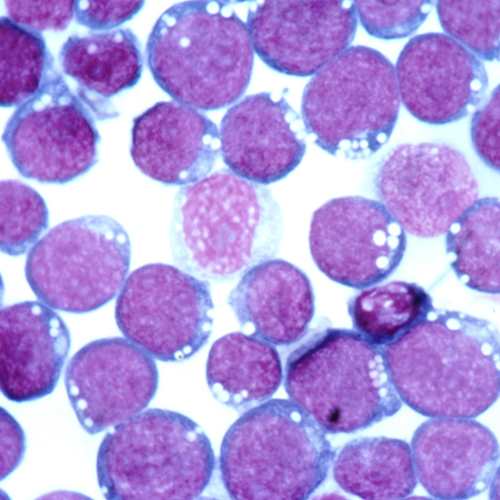EBV-Conditioned SML Medium
Conditioned medium containing Epstein-Barr virus (EBV) is derived from a New World squirrel monkey cell line (SML) that sheds high levels of EBV.
Highlights:
- Squirrel monkey lymphoblast conditioned medium containing Epstein-Barr virus (EBV)
- Demonstrates similar levels of EBV shedding as B95-8 cell medium and the same efficiency of human B-cell transformation
- Will transform the human cells within 3-4 weeks
Epstein–Barr virus (EBV), formally called Human gammaherpesvirus 4, is one of the nine known human herpesvirus types in the herpes family (one of the most common viruses in humans) and is a double-stranded DNA virus. Immortalization of human primary B lymphocytes with Epstein-Barr virus (EBV) has been used extensively to generate lymphoblastoid cell lines for the production of fully human monoclonal immunoglobulins as well to provide genetic and protein material from a single source. EBV stocks for transformation of human B-cells have standardly been derived from conditioned medium from New World cotton-top tamarin B95-8 cells. However, cotton-top tamarins are now listed as endangered by the U.S. Fish and Wildlife Service, and organizations like the ATCC are no longer distributing the cell line.
From the laboratories of Jonathan G. Scammell, PhD and Robert A. Barrington, PhD, University of South Alabama.
Conditioned medium containing Epstein-Barr virus (EBV) is derived from a New World squirrel monkey cell line (SML) that sheds high levels of EBV.
Highlights:
- Squirrel monkey lymphoblast conditioned medium containing Epstein-Barr virus (EBV)
- Demonstrates similar levels of EBV shedding as B95-8 cell medium and the same efficiency of human B-cell transformation
- Will transform the human cells within 3-4 weeks
Epstein–Barr virus (EBV), formally called Human gammaherpesvirus 4, is one of the nine known human herpesvirus types in the herpes family (one of the most common viruses in humans) and is a double-stranded DNA virus. Immortalization of human primary B lymphocytes with Epstein-Barr virus (EBV) has been used extensively to generate lymphoblastoid cell lines for the production of fully human monoclonal immunoglobulins as well to provide genetic and protein material from a single source. EBV stocks for transformation of human B-cells have standardly been derived from conditioned medium from New World cotton-top tamarin B95-8 cells. However, cotton-top tamarins are now listed as endangered by the U.S. Fish and Wildlife Service, and organizations like the ATCC are no longer distributing the cell line.
From the laboratories of Jonathan G. Scammell, PhD and Robert A. Barrington, PhD, University of South Alabama.
| Product Type: | Virus |
| Name: | EBV-Conditioned Medium |
| Source: | Squirrel monkey lymphoblast (SML) cells |
| Biosafety Level: | BSL-2 |
| Virus: | EBV |
| Comments: | Media contains phenol red indicator and serum (standard level). |
| Storage: | -80C |
| Shipped: | Dry Ice |
From the laboratories of Jonathan G. Scammell, PhD and Robert A. Barrington, PhD, University of South Alabama.
- Reynolds PD, Roveda KP, Tucker JA, Moore CM, Valentine DL, Scammell JG. Glucocorticoid-resistant B-lymphoblast cell line derived from the Bolivian squirrel monkey (Saimiri boliviensis boliviensis). Lab Anim Sci. 1998 Aug;48(4):364-70. PMID: 10090044.
- Miller G, Shope T, Lisco H, Stitt D, Lipman M. Epstein-Barr virus: transformation, cytopathic changes, and viral antigens in squirrel monkey and marmoset leukocytes. Proc Natl Acad Sci U S A. 1972 Feb;69(2):383-7. doi: 10.1073/pnas.69.2.383. PMID: 4333982; PMCID: PMC426463.
If you publish research with this product, please let us know so we can cite your paper.


